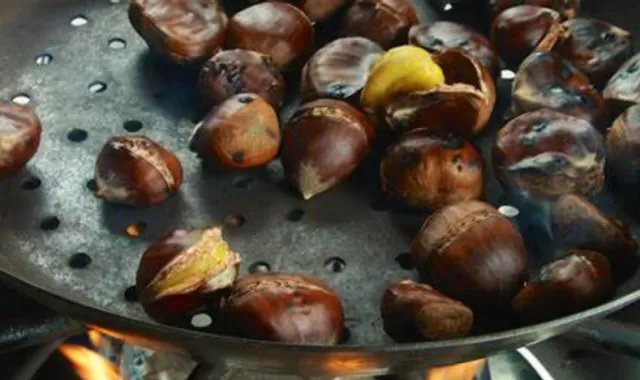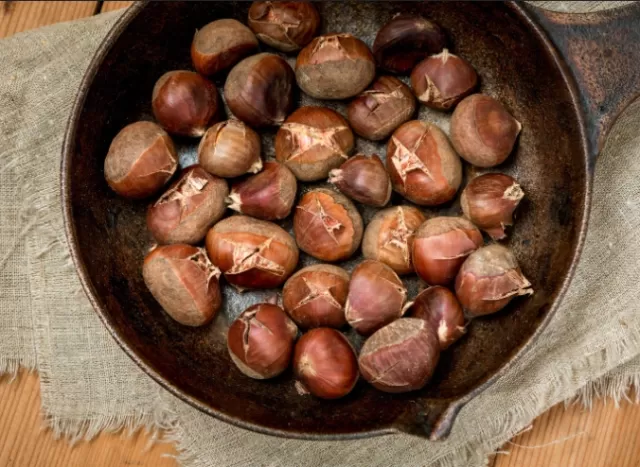Perfect Chestnut Roasting Without the Open Fire. While classic crooners like Nat King Cole and Bing Crosby have serenaded us with tales of roasting chestnuts on an open fire During the Holiday Season, have you made this timeless tradition your own? Across various cultures, chestnut trees and the rituals of their winter harvest are intertwined with festive celebrations, and cuisines around the world feature special recipes that showcase the rich, nutty flavor of chestnuts.
In the United States, the aroma of roasted chestnuts serves as an unmistakable indicator that the holiday spirit is in full swing. The good news is that you don’t need an open hearth to partake in this delightful tradition; it can be enjoyed right in your apartment. Our guide on how to roast chestnuts ensures that you can recreate this heartwarming experience, filling your home with the comforting scent of warm, buttery chestnuts. Whether enjoyed as a snack or incorporated into your favorite seasonal recipes, roasted chestnuts add a touch of nostalgia and culinary warmth to your holiday festivities.
Join us on this journey as we share the art of roasting chestnuts, allowing you to savor the essence of a time-honored tradition and create cherished moments in the heart of your home, no matter the size or setting.
Safeguarding the Vibrancy of Radicchio: An In-Depth Guide to Proper Preservation

Ensuring the enduring freshness of radicchio demands meticulous attention to proper storage techniques.
Franco Fubini, an authority in produce and founder of Natoora, provides valuable insights for an optimal storage experience:.
Head Protection:Preserve the integrity of radicchio heads by shielding them from excessive light exposure.
An ideal method involves covering the heads with an opaque material, such as a plastic bag. This not only prevents prolonged photosynthesis but is also instrumental in maintaining the quality and distinctive flavor of the radicchio.
Chilled Preservation:For an extended shelf life, place the covered radicchio heads in the refrigerator.
The cool temperature acts as a natural decelerant, mitigating potential deterioration and effectively preserving the crisp texture and delectable taste of the leaves.
By incorporating these straightforward yet highly effective storage practices into your routine, you can significantly prolong the shelf life of radicchio, ensuring its culinary versatility remains at its peak for an extended duration.
How to Roast Chestnuts in the Oven
What you need: A sharp paring knife, cutting board, rimmed baking sheet (or roasting pan or oven-safe skillet), and a clean kitchen towel.
Preheat the oven: A standard temperature of 350°F is great for roasting chestnuts.
Make an “X”: Using the base of a sharp paring knife, make a very small (about ⅛-inch) incision through the bottom of each chestnut’s shell.
Cut just until you hit the flesh of the nut, and maneuver the knife all the way up the bottom half of the shell. Then do it again to make an “X.
” This way, when the chestnuts roast, the shells will crack open completely, and peeling will be easier.
Soak: Soak the chestnuts in a bowl of water for 30 minutes; this will help ensure they don’t dry out when roasting.
Roast: Arrange the chestnuts in an even layer on a rimmed baking sheet.
Roast for about 35 minutes, or just until the shells have cracked and the nuts inside are exposed.
Peel: Chestnuts are easiest to peel while they’re still hot, so grab a clean kitchen towel and use it to pry open the shells.
Discard each shell and any papery skins that are attached to the nuts.
Chestnuts can be a tough nut to crack, but when they are cooked properly, the shells slip off pretty easily.
The trick is to make sure the inner nut is thoroughly cooked and tender before peeling. And of course, make sure to peel the nuts while they’re still hot from the oven.
Mastering the Art of Oven-Roasted Chestnuts: A Step-by-Step Guide

Gathering Your Tools:Equip yourself with a sharp paring knife, a cutting board, a rimmed baking sheet (or opt for a roasting pan or oven-safe skillet), and a clean kitchen towel.
Preheat the Oven:Set the oven to a standard temperature of 350°F, creating the perfect roasting environment for chestnuts.
Making the “X” Incision:With the base of a sharp paring knife, delicately create a small (approximately ⅛-inch) incision through the bottom of each chestnut’s shell.
Ensure the cut penetrates just until the flesh of the nut is reached, and smoothly maneuver the knife up the bottom half of the shell, repeating the process to form an “X. ” This strategic incision facilitates the cracking of the shells during roasting, making the subsequent peeling process more seamless.
Soaking for Moisture:Place the chestnuts in a bowl of water and let them soak for 30 minutes.
This pre-roasting step helps prevent the chestnuts from drying out during the roasting process.
Roasting Arrangement:Arrange the soaked chestnuts in a single layer on the rimmed baking sheet, ensuring even distribution.
Time to Roast:Allow the chestnuts to roast in the preheated oven for approximately 35 minutes, or until the shells have cracked open, revealing the tantalizing nuts inside.
Peeling Perfection:Timing is crucial for the peeling process.
While the chestnuts are still hot from the oven, employ a clean kitchen towel to assist in prying open the cracked shells. Discard both the shells and any papery skins clinging to the nuts.
Pro Tip:Achieving chestnut perfection involves ensuring the inner nut is thoroughly cooked and tender before attempting to peel.
Always remember to peel the chestnuts while they are still warm from the oven to maximize ease and efficiency in the peeling process.
Diverse Culinary Paths for Chestnut Delight: Beyond Roasting
While roasting chestnuts undoubtedly enhances their deep, earthy flavor, there exist alternative cooking methods that cater to distinct culinary preferences, especially if you’re seeking to emphasize texture over taste.
Here are two alternative approaches: boiling and steaming.
Boiling Method:.
Preparation: Before boiling, make a small incision on the bottom of each chestnut, similar to the roasting method.
Boil: Place the prepared chestnuts in a pot of boiling water, ensuring they are fully submerged.
Cooking Time: Boil for approximately 15-20 minutes or until the chestnuts’ texture suits your preference.
Peeling: Once boiled, peel the chestnuts while they’re still warm for optimal ease.
Steaming Technique:.
Initial Steps: As with roasting and boiling, make the characteristic “X” incision at the base of each chestnut.
Steam: Set up a steamer basket over simmering water and place the chestnuts inside, allowing them to steam.
Steaming Duration: Steam for approximately 20-25 minutes, adjusting the time based on your desired chestnut texture.
Peeling Perfection: Similar to the other methods, peel the chestnuts while they’re warm for a smoother peeling experience.
Exploring these alternative cooking methods provides a spectrum of textures, allowing you to tailor the culinary experience to your preferences.
Whether you prefer the robust flavor from roasting or the focus on texture through boiling or steaming, each method brings its own unique appeal to the delightful world of chestnut preparation.
Elevating Your Culinary Experience: Serving and Savoring Roasted Chestnuts

The joy of roasted chestnuts extends beyond the simple pleasure of enjoying them warm from the oven, perhaps with a delicate sprinkle of salt.
Here are delightful ways to incorporate roasted chestnuts into your holiday recipes, adding a touch of warmth and richness to both savory and sweet dishes.
Savory Creations:.
Chestnut Stuffing: Elevate your festive meals with the addition of chestnut stuffing, whether served as a standalone side or nestled within a savory roast.
Vegetable Companions: Explore the savory realm by pairing chestnuts with hearty vegetables such as fennel or Brussels sprouts, imparting a delightful meatiness to your dishes.
Creamy Indulgences: Introduce chestnuts to creamed greens, enhancing the texture and flavor profile.
They also make a decadent addition to the beloved green bean casserole.
Soup Sensations: Bulk up creamy mushroom or pumpkin soups with chestnuts, blending their nutty essence and chewy texture seamlessly into the mix.
Sweet Delights:.
Dessert Elegance: Harness the wonderful flavor and texture of chestnuts to elevate desserts.
They work impeccably as a creamy filling for sandwich cookies or layer cakes, adding a nuanced richness.
Flour Transformation: Transform chestnuts into a fine powder akin to chestnut flour, similar to almond flour.
This versatile ingredient can be used in baking, making it perfect for crafting delectable pancakes, crepes, and meringues.
Whether you’re embracing the savory warmth of chestnuts in festive feasts or exploring their sweet side in delightful desserts, the versatility of roasted chestnuts opens up a world of culinary possibilities, ensuring a memorable and flavorful dining experience.
*The information is for reference only.